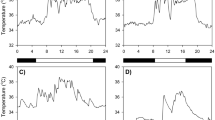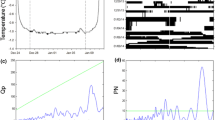Abstract
Golden hamsters and thirteen-lined ground squirrels were maintained individually in a thermal gradient (14°C to 33°C) for several weeks under a 14L: 10D light-dark cycle. Animals of both species showed robust daily rhythms of body temperature and locomotor activity with acrophases consistent with the habits of the species (diurnal acrophases in the diurnal squirrels and nocturnal acrophases in the nocturnal hamsters). Hamsters showed a robust daily rhythm of temperature selection 180° out of phase with the rhythms of body temperature and locomotor activity. Squirrels did not show a daily rhythm of temperature selection. These results raise the hypothesis that a daily rhythm of temperature selection is exhibited by nocturnal but not by diurnal endotherms.
Similar content being viewed by others
References
Aschoff J (1970) Circadian rhythm of activity and body temperature. In: Hardy JD, Gagge AP, Stolwijk JAJ (eds) Physiological and behavioral temperature regulation. Thomas, Springfield, pp 905–919
Briese E (1985) Rats prefer ambient temperatures out of phase with their body temperature circadian rhythm. Brain Res 345: 389–393
Briese E (1986) Circadian body temperature rhythm and behavior of rats in thermoclines. Physiol Behav 37: 839–847
Cabanac M (1979) Le comportement thermorégulateur. J Physiol (Paris) 75: 115–178
Gordon CJ (1993) Twenty-four hour rhythms of selected ambient temperature in rat and hamster. Physiol Behav 53: 257–263
Gordon CJ (1994) Twenty-four hour control of body temperature in the rat. I. Integration of behavioral and autonomic effectors. Am J Physiol 267: R71-R77
Hensel H (1981) Thermoreception and temperature regulation. Academic Press, New York
Kluger MJ (1991) Fever: Role of pyrogens and cryogens. Physiol Rev 71: 93–128
Refinetti R (1995) Rhythms of temperature selection and body temperature are out of phase in the golden hamster. Behav Neurosci 109: 523–527
Refinetti R, Menaker M (1992) Review: the circadian rhythm of body temperature. Physiol Behav 51: 613–637
Sokolove PG, Bushell WN (1978) The chi square periodogram: Its utility for analysis of circadian rhythms. J Theor Biol 72: 131–160
Author information
Authors and Affiliations
Rights and permissions
About this article
Cite this article
Refinetti, R. Body temperature and behaviour of golden hamsters (Mesocricetus auratus) and ground squirrels (Spermophilus tridecemlineatus) in a thermal gradient. J Comp Physiol A 177, 701–705 (1995). https://doi.org/10.1007/BF00187629
Accepted:
Issue Date:
DOI: https://doi.org/10.1007/BF00187629




